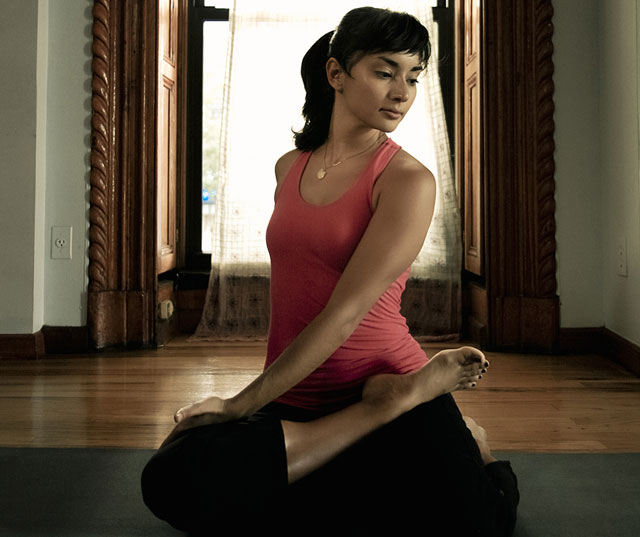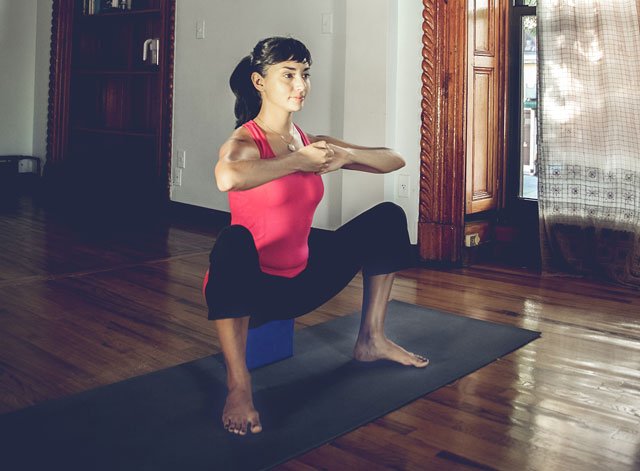
There was a day in late August when everything suddenly felt a little lighter, and a soft breeze made it easier to breathe. It happened overnight. The shift from hot, humid nights to being able to sleep with a blanket was here. The quality of the air was less heavy and there was a little pep in our step—almost like being lifted. We’ve spent most of September adjusting to the shifts, and now autumn has officially set in. How does that affect us and our yoga practice?
Change is constant and we all have different reactions to it. We see nature morph and respond to the presence of less or more light, wind, and water, and so our physical and subtle bodies absorb and mirror these responses. But change is hard—and sometimes our bodies don’t take well to it. We may begin to notice and feel reactions that hinder our ability to stay balanced and at peace. With the help of yoga’s sister science, Ayurveda, we can identify the elements that are shifting inside and outside of our bodies. Through this understanding, we can navigate the change of this season with ease with some helpful tips ranging from suggested food choices to what yoga poses to focus on.
WHAT IS AYURVEDA?
Ayurveda is a Sanskrit word that means “the science of life and longevity”. It allows us to find harmony with the laws of nature. Dating back 5,000 years from India, Ayurveda reveals how to prevent illness, heal through natural means, and stay in balance.
I like to think of it as preventive care at its best, being able to approach our health from an anticipatory standpoint as opposed to treating illness with drugs and surgery. Imbalances occur when there is “dis-ease” in the body. Literally, the body is not able to function with ease. The first step is identifying what we are working with and sharpening our awareness of it.
The principles of Ayurveda are based on five natural elements that exist in nature and in our bodies: space, air, fire, water, and earth. These elements are organized into primary energies called doshas. The three doshas are: vatta (space and air), pitta (fire and water) and kapha (water and earth). Fall is known as vatta season, winter as kapha season, and summer as pitta season. Each body contains different amounts of each dosha making up our unique Ayurvedic composition. I continue to be amazed by the power of Ayurveda’s intuitive nature.
The freshness of the air in this fall/vatta season wipes the slate clean, making space for new things. It is a perfect time to start something new and set some new goals. Creative energy is all around us in the autumn, so be sure to feel supported by this while also remaining aware that you may feel a bit ungrounded or tired as a result. But there are things we can do to better balance, understand, and integrate this excitement!
Having grown up in California, the word “season” didn’t really mean much to me. Living in New York for more than a decade, I have come to appreciate the transformations and see that each season has a personality. Understanding how to prevent myself from going out of balance during seasonal shifts has helped me to stay in balance through all kinds of life transitions and ultimately, appreciate change. After all, it’s New York. It’s a dramatic place where so much can happen in one moment—so my practice helps remind me that this inevitability is normal and that, as my teacher Ali Cramer reminds me, “You can’t control change, but you can control your reaction to it.”

Let’s look at our diet first to see how we can balance out the dominant vatta dosha that fall brings. One of the best ways to stay grounded is by paying attention to what you eat. Kapha foods come from the earth, the soil. Root vegetables are key during this time of year. Beets, carrots, turnips, leeks, parsnips, and onions will help ward off feelings of spaciness and bring us “back to earth”. Even foods that grow close to the earth or out of it, such as squashes, zucchini, asparagus, and cabbage are helpful.
Stay away from raw foods—they are too cooling when we need to cultivate more heat. Salad lovers, experiment with warm salads. Cook your food and eat it warm. Add a little pitta heat with some added spiciness, like cayenne and black pepper. Keep it warm for fruits, too. Bake, poach, or stew fruits of the season. Baked apples are great for this time of year!
Because of the dryness that occurs with so much wind, keep your organs and skin lubricated. Try cooking with more oil: ghee (clarified butter), sesame oil, flax seed oil, pumpkin seed oil; add cheese and yogurts to your meals. Instead of drinking just plain water (which you should be drinking lots of) integrate diluted yogurt, almond milk, coconut milk, rice milk, and hemp milk.
And if you feel your head is in the clouds, experiment with the color red. Red is a grounding color and also the color of the first chakra, known as the Muladhara (root) chakra starting from the soles of the feet and extending to the bottom of the pelvic floor. Red pants can be awesome for the fall time, red nail polish, red socks, and even red underwear!
Consistency and routine are pathways to counteracting the flighty nature of vatta season. What better way to introduce routine than in your yoga and meditation practice. Setting aside just ten minutes a day, preferably the same time of day and in the same place, will anchor you. Add consistency by journaling, completing a daily chore, taking a walk, or making your breakfast every day. Regular rest is crucial during this time of year. The body will naturally need more sleep. Give in to taking a nap or scheduling an extra hour of sleep.
Ayurveda teaches us that every choice we make about what we put into and onto our body affects our overall harmony.
AYURVEDA AND YOGA
Here are suggestions on how to calm the air element, steady the mind, strengthen the body, and enrich the soul. These are options to take with you to your next yoga class or try on your own. Just as our aim was to ground and heat ourselves with our food and lifestyle choices, the same idea goes for our yoga poses as well. (If you are recovering from a specific injury or surgery, seek the guidance of a trained yoga teacher.)
During this time, excess air gets trapped in the pelvic region and we are working to release that air. Child’s pose, Balasana, is immediately grounding. If you are taking a fast-paced yoga class and feeling anxious, take your knees down the mat, move your seat back to your heels, reach your arms forward, and let your forehead rest on the ground or a block.
Slow it down and find more stillness in all poses to activate a sense of stability. Take slower sun salutations, Surya Namaskar. Elongate your inhales and exhales. Experiment with retaining the breath between the inhales and exhales. Use more props (blocks, blankets, and straps) in poses so that the ground comes to you and you prevent yourself from straining. Are the poses and intention behind each pose bringing you into balance or taking you out of balance? Take a longer Savasana, corpse pose.
Squat poses are stabilizing as our pelvis draws closer to the ground and we tap into the strength of our feet and legs while releasing excess vatta. Take a wide squat pose, Malasana, (see above) using a block or a few pillows to support your seat. Take your hands to your chest with your left palm facing out and take your right palm facing in. Clasp the fingers. Find Ganesh mudra This hand seal represents the Hindi deity, Ganesh, the elephant god that rules the first root chakra. Inhale, soften the grasp and as you exhale, let your elbows draw away from each other. Do six rounds of breath total and then switch the facing of the palms. If your heels do not reach the ground quite yet, roll up a blanket or towel so your heels are making contact with something.
Standing, forward-bending poses create space and balance in the feet and legs. Take a variation of your standing forward bend by crossing your ankles, Uttanasana. Use blocks or big books to support your body so you are not straining the back of the legs. Slightly bend your knees to provide relief to your lower back. Rock a bit more weight into the balls of your feet. Square off your hips and let the weight of your head go. Stay here for twelve rounds of breath. Enjoy the benefits of this inversion, where the heart is above the head. Cross the other ankle in front.
Cultivating balance comes with the testing of our balance. What better way than to stand on one leg! Release the foot that is crossed behind you into a warrior 3, Virabhadrasana 3. Keep the raised foot flexed and let the toes point down as the heel reaches behind you. The standing foot stays internally rotated and the hips are in line with each other. Stay with your hand on the blocks. For more heat in the pose, let your hands form a prayer in front of the chest. Draw your leg to be in line with your torso, and allow your gaze to move out in front of you so your chest is not collapsing down. Stay for five rounds of breath. Do the other side.
The best way to connect to the ground, is to come closer to it. Sit on the floor. This suggested pose brings instant peace with an added sweetness. Bend your left leg and slide your left foot to the outside of your left hip with your knee and shin on the ground. Take the right foot to the inside of the left thigh with the right knee open the side. Inhale your hands up, and on the exhale twist to the right, letting the left hand come on the outside of the right knee and the right hand tent behind you. Look at your left shoulder as if someone is going to give you a kiss on the right cheek. This is Bharadvajasana (see page 19). Close your eyes for added bliss. The body is experiencing a lot of twisting, creating a quiet fire while finding tranquility in the legs. Stay for nine rounds of breath. Variation: you can take a half lotus with the right foot and the right hand can come to grab the right foot for a deeper twist. Be sure to take a little counter twist to the other side after you are done. Do the other side.
Ayurveda and yoga remind us that we all have the means to center and balance ourselves. By listening and sharpening our awareness of what is both within and around us, we can make informed, conscious decisions and take responsibility for our own well-being.
Happy fall! ◆
Contact Veronica at veronicacarnero@gmail.com with inquiries on private and group class yoga sessions throughout Brooklyn.

Leave a Reply